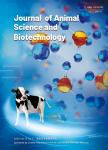Identific tion of quantitative trait loci and associated candidate genes for pregnancy success in Angus–Brahman crossbred heifers
作者机构:Department of Animal SciencesDonald Henry Barron Reproductive and Perinatal Biology Research Programand the Genetics InstituteUniversity of FloridaGainesvilleFLUSA School of Applied Systems BiologyLa Trobe UniversityBundooraVIC 3083Australia
出 版 物:《Journal of Animal Science and Biotechnology》 (畜牧与生物技术杂志(英文版))
年 卷 期:2024年第15卷第1期
页 面:162-170页
核心收录:
基 金:supported by Grant no.2017-67007-26143 from the Agriculture and Food Research Initiative of USDA-NIFA the L.E.“Red” Larson Endowment and Florida Cattleman’s Association supported by USDA NIFA grant 2021-38420-34067
主 题:Beef cattle Fertility GWAS QTL
摘 要:Background In beef cattle, more than 50% of the energy input to produce a unit of beef is consumed by the female that produced the calf. Development of genomic tools to identify females with high genetic merit for reproductive function could increase the profitability and sustainability of beef *** Genome-wide association studies(GWAS) were performed using a single-step genomic best linear unbiased prediction approach on pregnancy outcome traits from a population of Angus–Brahman crossbred heifers. Furthermore, a validation GWAS was performed using data from another farm. Heifers were genotyped with the Bovine GGP F250 array that contains 221,077 SNPs. In the discovery population, heifers were bred in winter breeding seasons involving a single round of timed artificial insemination(AI) followed by natural mating for 3 months. Two phenotypes were analyzed: pregnancy outcome to first-service AI(PAI;n = 1,481) and pregnancy status at the end of the breeding season(PEBS;n = 1,725). The heritability was estimated as 0.149 and 0.122 for PAI and PEBS, respectively. In the PAI model, one quantitative trait locus(QTL), located between 52.3 and 52.5 Mb on BTA7, explained about 3% of the genetic variation, in a region containing a cluster of γ-protocadherin genes and SLC25A2. Other QTLs explaining between 0.5% and 1% of the genetic variation were found on BTA12 and 25. In the PEBS model, a large QTL on BTA7 was synonymous with the QTL for PAI, with minor QTLs located on BTA5, 9, 10, 11, 19, and 20. The validation population for pregnancy status at the end of the breeding season were Angus–Brahman crossbred heifers bred by natural mating. In concordance with the discovery population, the large QTL on BTA7 and QTLs on BTA10 and 12 were *** In summary, QTLs and candidate SNPs identified were associated with pregnancy outcomes in beef heifers, including a large QTL associated with a group of protocadherin genes. Confirmation of these associations



